Chapter 2. Customizing and Configuring Your NOOK Color
Your NOOK Color has many features that enable you to easily customize it and make it your own. There are also many settings that control how your NOOK Color operates. In this chapter, you examine how to customize and configure your NOOK Color.
Using Custom Wallpaper
You can customize your NOOK Color by using custom wallpaper images. Wallpaper appears on the Home pages when you are on the Home screen.
Choosing a Wallpaper
The easiest place to change your NOOK Color’s wallpaper is to go to the Home screen. Here’s how:
1. Make sure your NOOK Color is at the Home screen by pressing the Home button.
2. In an area of the Home page without a cover, press and hold. A pop-up menu appears (see Figure 2.1).
Figure 2.1 This menu appears when you press and hold on a blank area of the Home page.
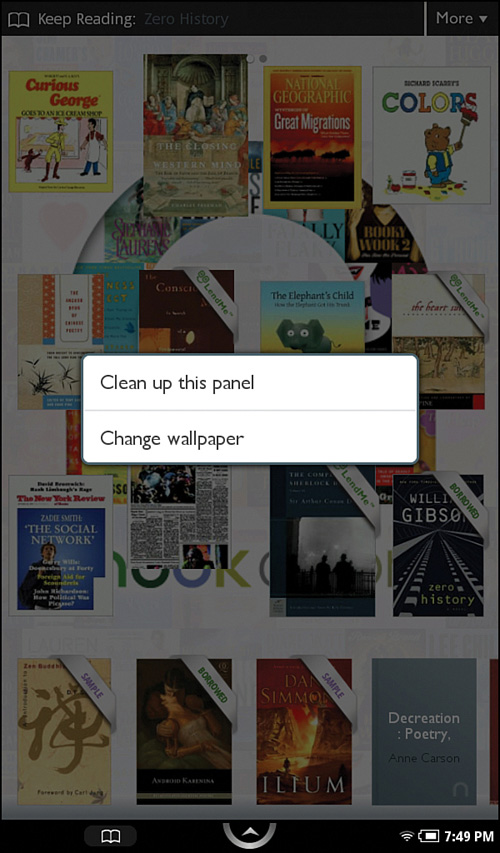
3. Tap Change Wallpaper.
4. Tap either Wallpaper or Photo Gallery (see Figure 2.2). Wallpaper are images provided by B&N or images you have loaded into the Wallpaper folder. Photo Gallery displays any photographs in JPG, PNG, or GIF formats you have placed on your NOOK Color.
Figure 2.2 Make use of B&N provided image, add your own, or browse the Photo Gallery.
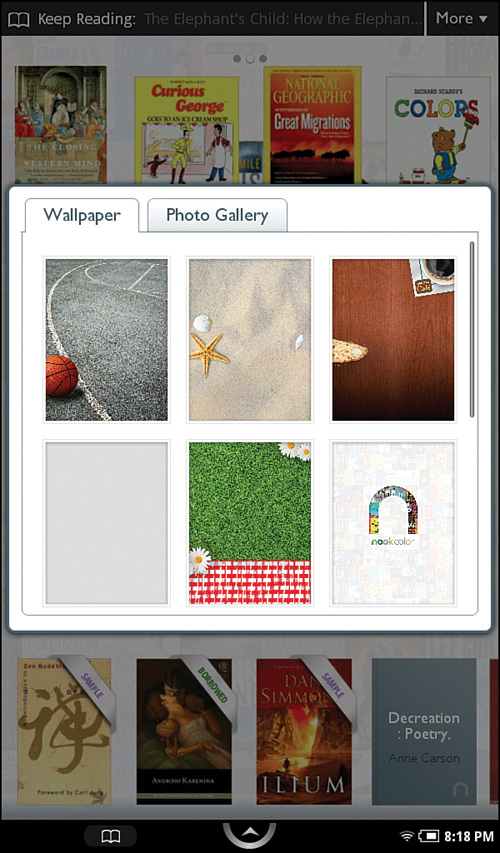
5. If you chose Wallpaper, choose the wallpaper you want, and you are taken back to the Home screen with that image as the wallpaper. If you chose Photo Gallery, choose the photo you want. An enlarged version of the photo appears with an orange outlined box and two buttons: Save and Discard.
You can place images you want to use for wallpaper in the Wallpaper folder on your NOOK Color. (Plug your NOOK Color into your computer and navigate to that folder.) Because the Photo Gallery displays every JPG, GIF, and PNG file on your NOOK Color, including cover images, the Photo Gallery list can quickly become lengthy.
6. The orange outlined box is for cropping the image to the size of the wallpaper (see Figure 2.3). Whatever is inside the orange outlined box will be used for the wallpaper. To move that box, press and hold and then drag it around to wherever you want it. Tap Save to make it the wallpaper and return to the Home screen, or tap Discard to exit to the Home screen.
Figure 2.3 Pick the area of the image you want to use for your Home screen.
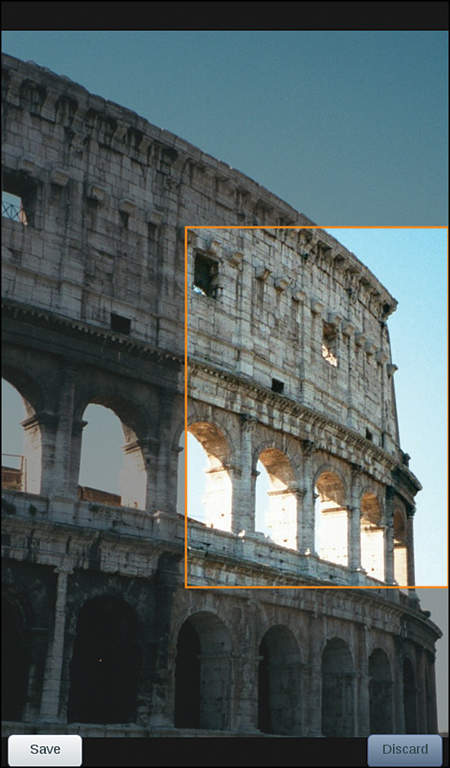
Following is a beneficial alternative method while you are browsing your photos:
1. Tap the Nav Arrow.
2. Tap Apps.
3. Tap Gallery.
4. Tap the photo you want to make your wallpaper. This makes that photo appear on the screen.
5. Tap the photo and then tap Wallpaper in the menu options that appear at the bottom of the image.
6. The orange outlined box is for cropping the image to the size of the wallpaper. Whatever is inside the orange outlined box appears as the wallpaper. To move that box, press and hold and then drag it around to wherever you want it. Tap Save to make it the wallpaper and return to the Home screen, or tap Discard to exit to the photo.
One Step Further—Decals
If you want to take the ultimate step in customizing your NOOK Color, a DecalGirl skin (www.decalgirl.com) is the perfect addition. DecalGirl skins are vinyl skins with adhesive backing that you can easily apply. Many skins also include matching NOOK Color wallpaper that provides a truly unique look.
Your NOOK Color’s Settings
Your NOOK Color offers configurable settings for controlling many of its features. Tap Settings on the Quick Nav Bar to access the Settings screen (see Figure 2.4).
Figure 2.4 The Settings screen contains many options.
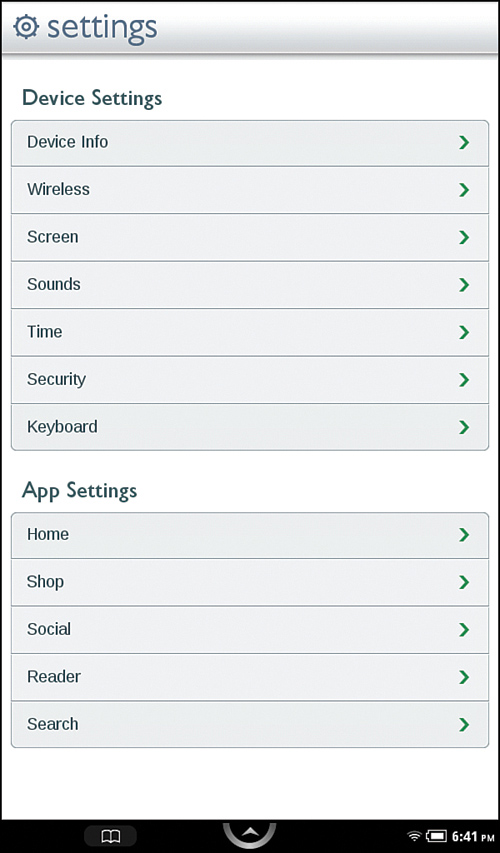
Device Info Menu
The Device Info menu shown in Figure 2.5 displays battery charge, available storage on the NOOK Color, microSD card storage, information about your NOOK Color, legal information, and a way to deregister the device. For more information on adding a microSD card to your NOOK Color, see “Adding and Using a microSD Card to Your NOOK Color.” This screen also displays your NOOK Color’s serial number along with your NOOK Color’s MAC address—the hardware address of the Wi-Fi modem.
Figure 2.5 The Device Info menu.
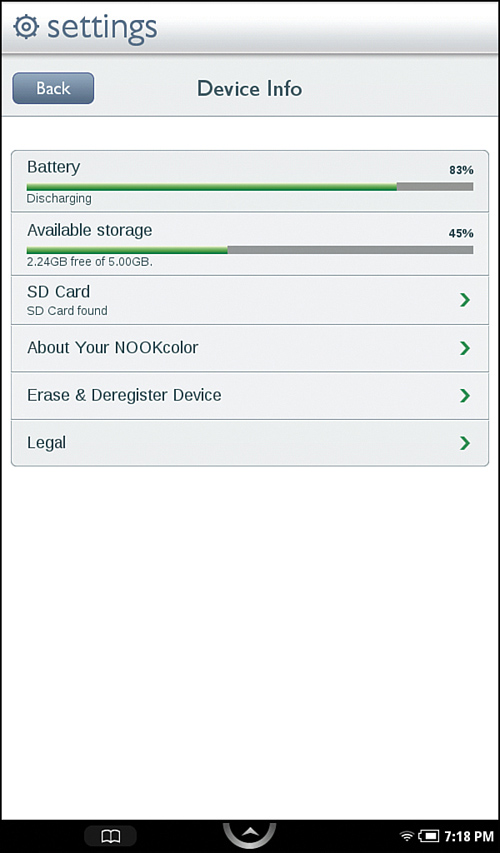
If you tap About Your NOOK Color, you see your profile information: owner name, account ID, and so on. Here you can see the software version (called firmware) currently installed on your NOOK Color. B&N releases periodic updates to the NOOK Color to improve performance and fix known issues. As long as your NOOK Color has a connection to a Wi-Fi connection, your NOOK Color can automatically download any updates that B&N releases.
Not all NOOK Color owners receive new firmware updates at the same time. B&N rolls out new firmware over a period of about a week. If you want to manually update your NOOK Color, you can visit www.barnesandnoble.com/NOOKcolor/support where B&N typically provides instructions for manually updating your NOOK Color to the latest firmware.
If you tap Erase & Deregister, you will be warned that doing so removes all books and files, including sideloaded content, and deregistering the device. Then you have a button to do just that. You should not do this except for potentially severe problems with the NOOK Color. More likely, you will use this if you are done with the NOOK Color and want to give it to a friend.
Note
Sideloaded content refers to all the ebooks from sources other than B&N and files you have placed on your NOOK Color. The action of putting these files and ebooks on the NOOK Color is called sideloading.
The Legal option provides more options to review the terms and conditions and such.
Wireless Menu
The Wireless menu provides options to turn the Wi-Fi on or off and to connect to Wi-Fi hotspots, which you have already done during the setup process in Chapter 1, “Getting Started with Your NOOK Color,” in the “Using Wi-Fi Hotspots” section.
Screen Menu
The Screen menu contains several options for configuring your NOOK Color’s display (see Figure 2.6):
• Auto-Rotate Screen: This setting, on by default, enables switching from portrait to landscape mode automatically. Your NOOK Color has an accelerometer in it that senses whether you hold the NOOK Color upright or on its side. Much content can be viewed in either fashion (though not all). If you are reading or viewing content that can be in either, whenever you change from portrait to landscape or vice versa, the content adjusts its orientation as well.
Some content, for example children’s ebooks, are set up for either portrait or landscape mode but not both. Turning off automatic orientation does not alter this. Therefore, if you have automatic orientation off, hold the NOOK Color in portrait mode, and open a children’s ebook, that ebook appears in landscape mode.
• Brightness: This setting controls the maximum brightness of the screen. To adjust the brightness, tap Brightness, and then drag your finger to adjust the slider (see Figure 2.7). When you are happy with the setting, tap OK to return to the menu.
• Screen Timeout: This controls the time interval after which your NOOK Color puts itself to sleep. This timer is set to 2 minutes by default. To change the interval, tap Screen Timeout, and then tap the preferred time interval.

Figure 2.7 Adjusting the brightness of your screen lower at night makes for easier reading.
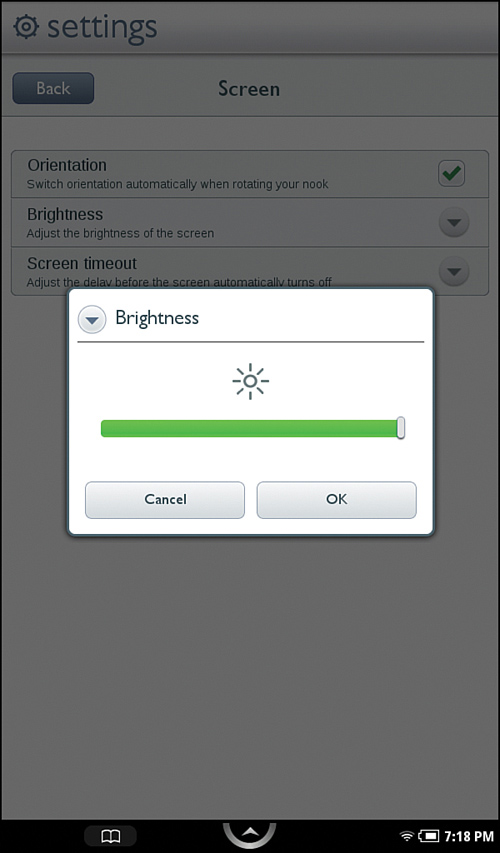
Tip
If you set the sleep timer to a time interval that is shorter than the amount of time it takes you to read a page on the reading screen, your NOOK Color goes into sleep mode while you are reading. So, be sure you set the interval appropriately for your reading speed.
Sounds Menu
The Sounds menu contains several options for configuring your NOOK Color’s sound settings (see Figure 2.8):
• Mute: This setting turns off all sound. Even though it says “except for media,” it mutes everything.
• Media: This setting adjusts the volume for music, videos, and other media sound such as the reading segments of children’s ebooks. To adjust the volume, tap Media Volume, and then drag your finger to adjust the slider. When you are happy with the setting, tap OK to return to the menu.
• Notification Volume: This setting adjusts the volume for notifications such as disconnecting the NOOK Color from your computer. To adjust the volume, tap Notification Volume, and then drag your finger to adjust the slider. When you are happy with the setting, tap OK to return to the menu.
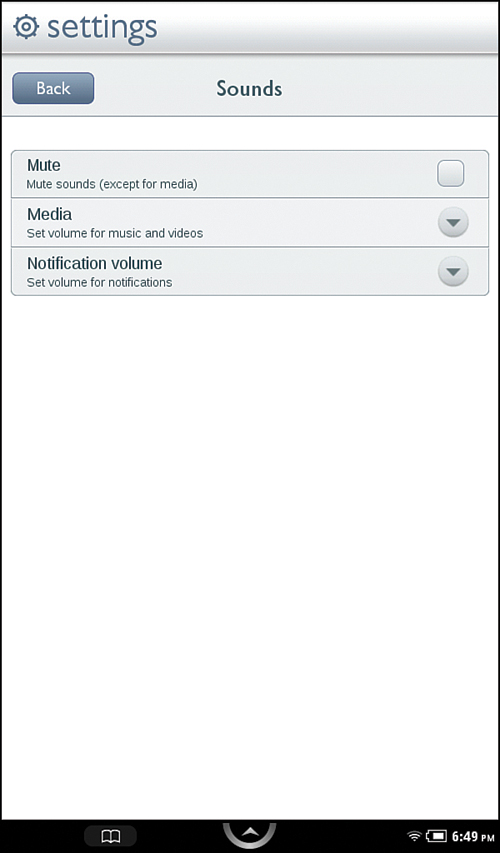
Time Menu
The Time menu contains several options for configuring your NOOK Color’s time settings (see Figure 2.9):
• Use 24-Hour Format: This enables you to choose between a 12-hour time format and a 24-hour time format.
• Select Time Zone: This setting enables you to select your current local time zone. Your NOOK Color normally gets the current time using Wi-Fi access. However, if Wi-Fi service isn’t available, it still displays the current time, provided you have configured your time zone. If you do not see the time zone you need here, tap Show All World Time Zones to see a longer list.

Security Menu
The Security menu contains several options for configuring your NOOK Color’s security settings (see Figure 2.10):
• Change Unlock Passcode: This enables you to choose a four-digit passcode (or PIN) to lock your NOOK Color when it goes to sleep or powers off (see Figure 2.11). Changing the passcode requires entering the soon-to-be-old passcode. (The first time you open this menu, you may see Set Unlock Passcode instead of Change Unlock Passcode.)
• Require Passcode: This setting enables the use of a passcode or not when the NOOK Color powers on or is awoken from sleep. To gain access to the content on the NOOK Color, a person must correctly enter the passcode.
Figure 2.10 The Security menu.
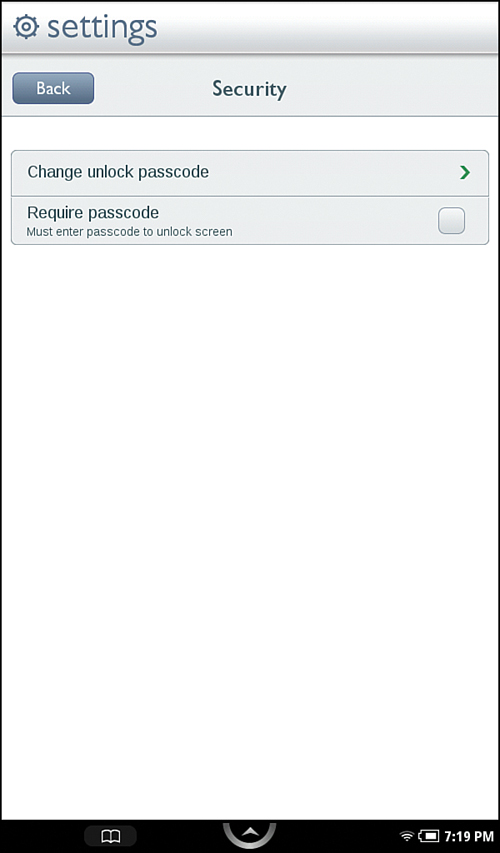
Figure 2.11 The passcode is a PIN for your NOOK Color.
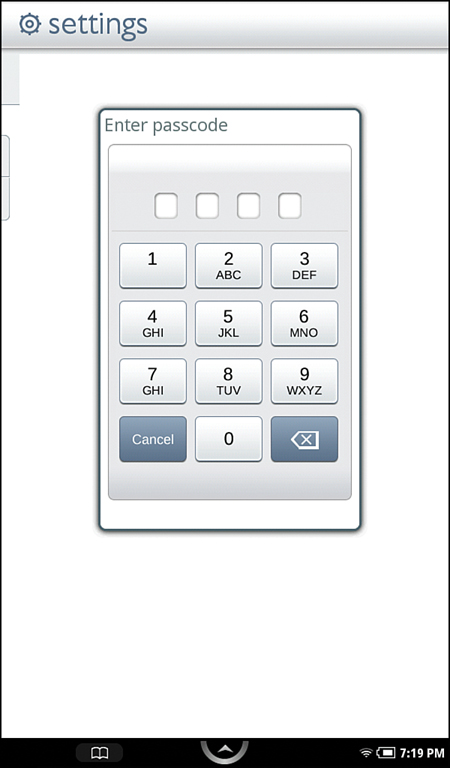
Note
Forgot your passcode? The good news is that you can get your NOOK Color back. The bad news is that you have to reset your NOOK Color to factory settings, which means you lose all content you placed on your device.
To reset your NOOK Color to factory settings:
1. With the NOOK Color off, hold the Home button and the Power button.
2. The NOOK Color starts up. Keep holding the buttons.
3. After a few seconds, you see a screen to reset your NOOK Color to factory settings with two options:
• Press Power to exit.
• Press Home to continue.
4. Press the Home button. You see the two options again.
5. Press the Home button.
6. Your NOOK Color erases the data, deregisters, and reboots the device.
Keyboard Menu
The Keyboard menu contains several options for configuring your NOOK Color’s keyboard settings (see Figure 2.12):
• Keyboard Sounds: This enables you to set whether, when you type on the virtual keyboard, you hear click sounds every time you tap a key.
• Auto-Capitalization: This setting enables the NOOK Color to auto-capitalize while typing. For example, if you type a period, for the next letter you type, the NOOK Color capitalizes it. (If you don’t want to capitalize that letter, tap the Shift key, which enables you to enter a lowercase letter.)
• Quick Fixes: This setting enables the NOOK Color to correct common misspellings. For example, if you type “teh,” the NOOK Color automatically changes that to “the.”
Figure 2.12 The Keyboard menu.
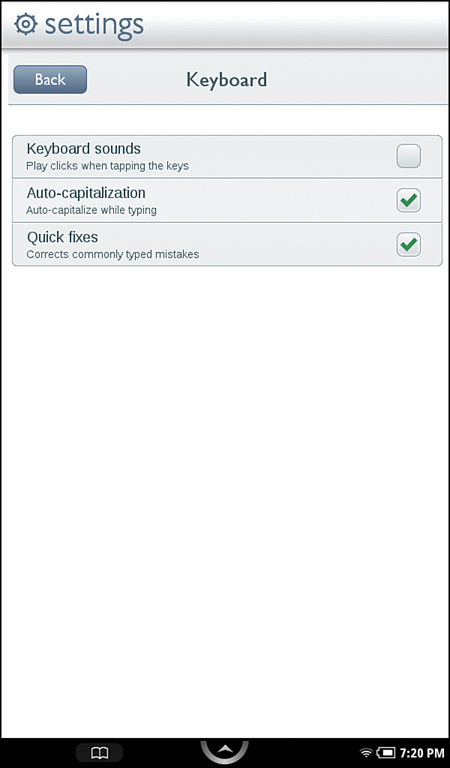
Home Menu
The Home menu contains several options for configuring your NOOK Color’s Home Screen settings (see Figure 2.13).
Figure 2.13 The Home Settings menu.
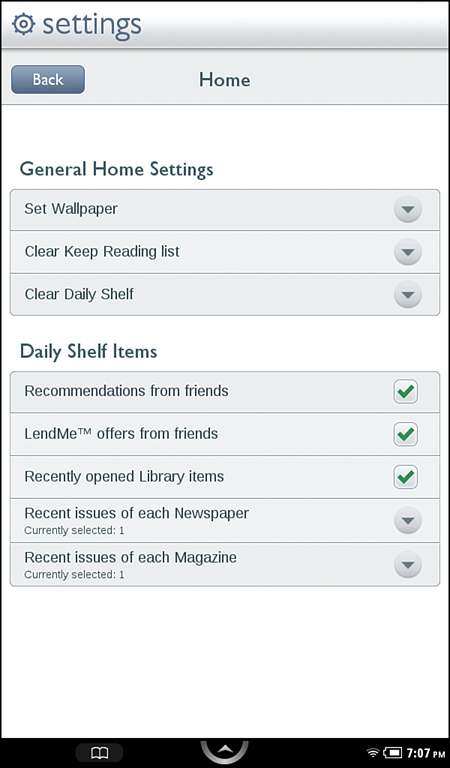
In the General Home Settings section:
• Set Wallpaper: This enables you to set the wallpaper. For more information about setting your wallpaper, see “Choosing a Wallpaper.”
• Clear Keep Reading List: This setting enables you to clear the Keep Reading and More lists. The lists starts anew as you read content.
• Clear Daily Shelf: This setting enables you to clear the daily shelf of items.
In the Daily Shelf Items section, you have a few more specific controls about what appears on the Daily Shelf. Each of the items enables you to select whether you want to see such items on the Daily Shelf. For Recent Issues of Each Newspaper and Magazine settings, tap the down-arrow button to see a list of options for how many issues you want to appear on the Daily Shelf. (The default is one.)
Shop Menu
The Shop menu contains several options for configuring your NOOK Color’s Shop settings (see Figure 2.14):
• Require Password for Purchases: This enables you to require a password entry for every purchase made through the B&N Bookstore on the NOOK Color. Leaving this option disabled means that when you click Buy in the bookstore, you purchase it without having to enter the password.
• Clear Shop Recent Searches: This setting enables you to clear the Shop Searches. Whenever you search the B&N Bookstore on the NOOK Color, it saves the recent searches. The searches are saved to make it easier to conduct searches. For example, you can search for ebooks related to Sherlock Holmes but decide not to purchase now. When you go back to the B&N Bookstore on your NOOK Color, you can type Sher, and Sherlock Holmes appears below the search text. You can then tap Sherlock Holmes and the search is performed.
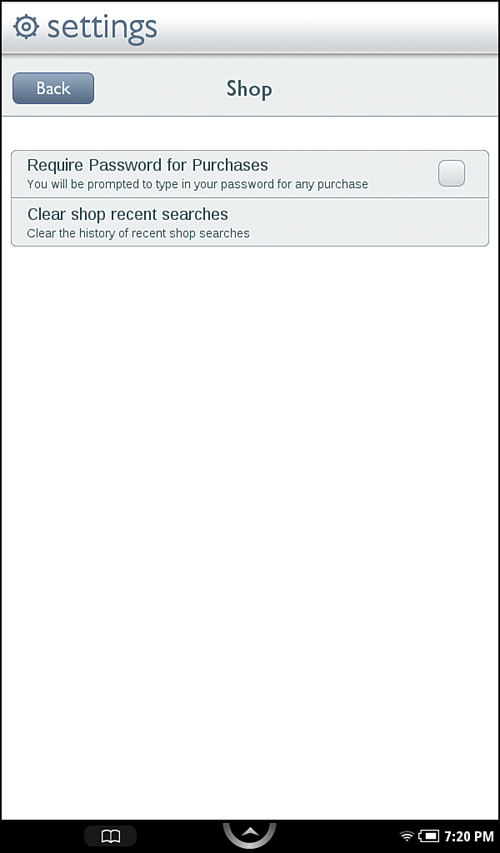
Social Menu
The Social menu contains several options for configuring your NOOK Color’s Social settings (see Figure 2.15). Basically, you can link your Facebook and Twitter accounts and Google Contacts lists to this NOOK Color, which enables you to share quotes and recommendations directly to your and your friends’ Facebook walls and Twitter account.
Figure 2.15 Connect your Facebook, Twitter, and Google Contacts with your NOOK Color here.
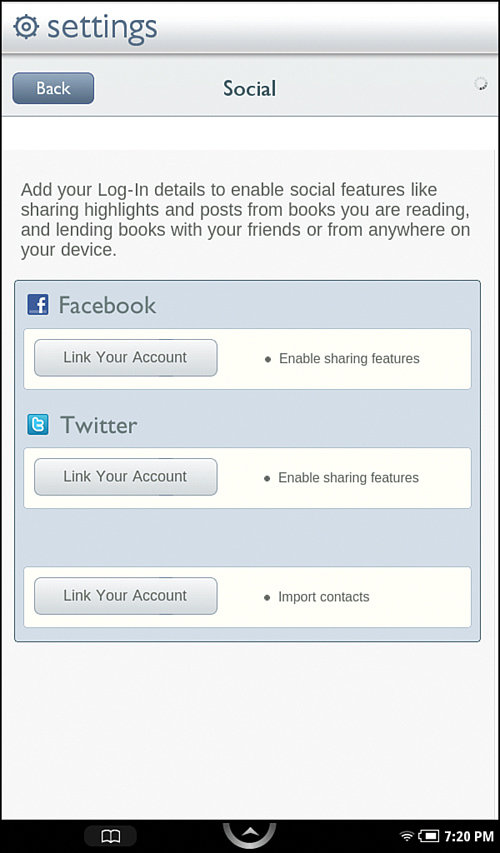
• Facebook: This enables you to link your Facebook account to your NOOK Color. If you have already linked your Facebook account, you can unlink it. To link it, tap Link Your Account. Then enter the required information and tap Log In (see Figure 2.16). For more information about Facebook with your NOOK Color, see Chapter 8, “Using the Social Features of Your NOOK Color.”
Figure 2.16 Link your Facebook account to your NOOK Color.
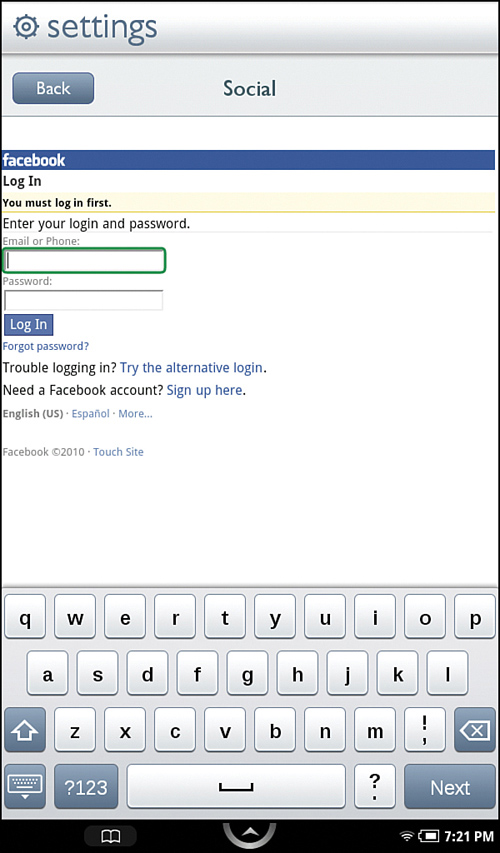
• Twitter: This enables you to link your Twitter account to your NOOK Color. If you have already linked your Twitter account, you can unlink it. To link it, tap Link Your Account. Then enter the required information and tap Sign In. Twitter asks you to allow this linking to occur. Tap Allow to do so (see Figure 2.17). For more information about Twitter with your NOOK Color, see Chapter 8.
Figure 2.17 Link your Twitter account to your NOOK Color.
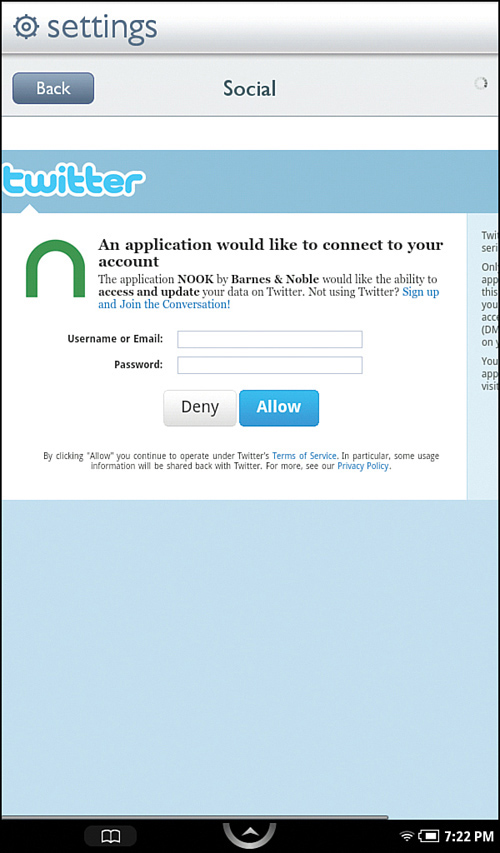
• Google Contacts: This enables you to link your Google Contacts list to this NOOK Color. If you have already linked your Google Contacts list, you can unlink it. To link it, tap Link Your Account. Then enter the required information. If you want the NOOK Color to remember this information should you come back to this screen, tap the Remember Me check box; then Tap Sign In. Google wants to know if you want to grant access to the NOOK Color to do this linking. Tap Grant Access to do so (see Figure 2.18).
Figure 2.18 Link your Google Contacts account to your NOOK Color.

Reader Menu
The Reader menu has one option: Animate eBook Page Turns. This is off by default. Tap the check box to turn it on.
The default behavior when you tap to change a page in an ebook is for the text on the screen to simply disappear and be replaced by the next page of text. With Animate eBook Page Turns on, however, when you tap to change a page in an ebook, you see the text on that page slide either left or right and the next page of text slide into view.
Search Menu
The Search menu contains several options for configuring your NOOK Color’s Search setting:
• Searchable Items: This enables you to adjust what searches are conducted on (see Figure 2.19). When you tap Search from the Quick Nav Bar, you can search a variety of different categories. By default, Apps, Browser, Music, Library, and Shop are searched. You can turn off searching on Apps, Browser, and Music.
Figure 2.19 Adjust search functions on your NOOK Color.
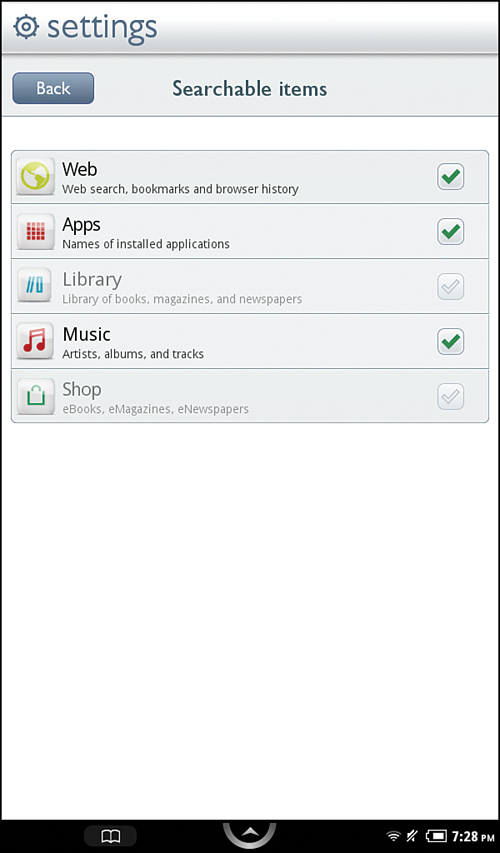
• Clear Search Shortcuts: This setting enables you to clear the list of recent searches. Whenever you search your NOOK Color, it saves the recent searches. The searches are saved to make it easier to conduct searches.
Adding and Using a microSD Card to Your NOOK Color
Your NOOK Color has approximately 8GB of built-in memory, though B&N reserves 3GB for the operating system and other NOOK Color items—leaving 5GB of memory for your use. That’s enough memory for an enormous library of books. However, it might not be enough memory if you add pictures, music, videos, and audiobooks to your NOOK Color. Therefore, your NOOK Color’s memory is expandable using a microSD card.
Caution
Some NOOK Color users have reported seeing only 1 GB or 5 GB of memory as the total memory when looking at the Settings for memory. I can tell you that this does not mean you have a smaller amount of memory on your device.
What it does mean is that B&N is giving you less space for videos, photos, and sideloaded content in general. Some of the latest devices reserve 7 GB for the NOOK Color operating system and B&N content (NOOK Books, magazines, apps, etc.). So when users see 1 GB total memory, they are seeing the amount of space they have for non-B&N content.
A microSD card is not the same as an SD memory card like the kind typically used in digital cameras. A microSD card is approximately the size of your fingernail.
Note
You will see both microSD and microSDHC. Your NOOK Color can use either format—they are the same. The HC is used for microSD cards greater than 2GB in size.
Installing a microSD card in your NOOK Color is easy—you don’t even need to turn off your NOOK Color:
1. Flip your NOOK Color over so that the speaker is at the bottom. On the bottom right, flip up the metal plate (it’s kept in place by a couple of small magnets) and pull it so that the small plastic connectors keeping the plate attached to the NOOK Color are fully extended.
2. The microSD slot is the small opening. With the metal connectors of the microSD card facing the front of the NOOK Color, slide the microSD card in, and push until it locks into place. The NOOK Color automatically recognizes the card, and you hear a beep. Close the metal plate.
3. If the microSD card has not yet been formatted, a screen appears letting you know that formatting it will erase everything on the disk. Tap Format Now. Tap Format Now again to confirm.
On the Device Info screen (from the Quick Nav Bar, tap Setting, and then tap Device Info), tap SD Card (only available to tap if a microSD card is installed). This opens the SD Card screen. Here, you can see information related to the amount of free memory available on the microSD card.
If you tap Format SD Card, you can format the microSD card, which erases everything on the card. (This option is only available after tapping Unmount SD Card.) A confirmation screen to format and erase all data on the micro SD card appears. Tap Format to do so. Tap OK when done.
1. From the SD Card screen, tap Unmount SD Card (see Figure 2.20).
Figure 2.20 The SD Card menu where you can safely dismount the card before removing it from your NOOK Color.

2. Flip your NOOK Color over so that the speaker is at the bottom. On the bottom right, flip up the metal plate (it’s kept in place by a couple of small magnets) and pull it so that the small plastic connectors keeping the plate attached to the NOOK Color are fully extended.
3. With your finger, push the microSD card further into the slot. The microSD card partially pops out, letting you get a grip on it to pull it out completely. Close the metal plate.
When you connect your NOOK Color to your computer, you now see your microSD card in addition to your NOOK Color’s built-in memory. (It is the drive called NO NAME.)
Note
You can add a microSD card that already has items loaded on it, but the NOOK Color folder structure is necessary, so it is easiest to install a blank microSD card into the NOOK Color and then plug the NOOK Color into your computer and load files into the appropriate categories (documents, videos, and so on).
Now that you have a microSD card installed, how do you access those files? From the Quick Nav Bar, tap Library and then tap My Files. You see two options near the top that you do not see if you do not have a microSD card installed: My NOOK Color and Memory Card. By default, you are looking at the My NOOK Color files. Tap Memory Card to switch to seeing the files on the microSD card. (Tap My NOOK Color to go back to the NOOK Color files.) You can then tap the folders and such just as if you were working with the My Files category. (For basic instructions in interacting with these files, see “Reading Microsoft Office and Other Documents on Your NOOK Color” in Chapter 3, “Reading on Your NOOK Color and Beyond.”)
